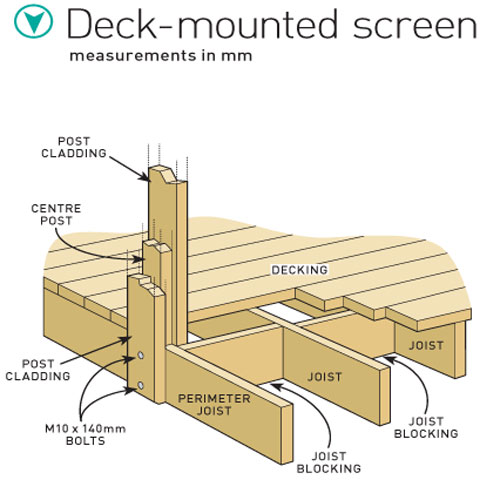Build a Privacy Screen

Make a freestanding fence from slatted timber to shield the yard from view.
We all love spending time outdoors, but without a fence or hedge the yard can feel quite exposed.
Brick walls can have an oppressive effect, especially on a small block of land, so this airy screen is the ideal compromise, keeping the yard secluded without being an obstacle to cool breezes or sunshine.
Made from treated pine, it’s 3600mm long and about 2100mm tall at the highest point. You can easily adapt the length and height to suit your site or even mount the screen on an existing deck.
The four posts that support the structure are rough-sawn H4 treated pine, which can be concreted directly into the ground. The remaining timber components are all cut to length from H3 rougher header treated pine.
A smooth finish on the cladding hides the rougher surface of the posts and also makes it easier to paint.
Cut the pickets and picket cap along the grain from 90 x 45mm treated pine using a tablesaw or circular saw with a fence fitted.
Remember to seal all the cut surfaces of treated pine with a preservative, oil-based paint or treated pine sealing agent.
To make finishing easier, prime and apply at least one coat of finish after the timber is cut to length, then apply the second coat once the structure is complete.
Before starting the construction, check with your local council in case building approval is required.
Dial 1100 or visit 1100.com.au to make sure there are no underground cables or pipes running through the post hole locations.
TIP If you have a sloping site, keep the rails level and cut the bases of the pickets so they are parallel with the ground.
Painting the screen
Clean all surfaces of dust and dirt then paint all components prior to assembly using a self priming low-sheen exterior acrylic.
Before applying the final coat, cover all nail and screw heads with an exterior timber filler and sand with 180 grit paper.
TIP Paint the pickets twice before installation using a small roller and 50mm brush.
Screen the deck
If you have an exposed deck that makes private gatherings feel like neighbourhood events, this screen can be easily adapted to solve the problem.
Decks usually have a single perimeter joist that’s the same thickness as the centre post, so in most cases you can easily remove an existing rail, notch the decking and straddle the perimeter joist with the post cladding.
Brace the perimeter joist with blocking to at least the second and third joist back to reinforce it. Using coachscrews to secure the end posts to an existing rail or house wall will also help to stabilise the screen.
Deck sizes vary widely, so to enclose an entire side you’ll need to work out the number of posts and their spacing, as well as the best finished height for the screen. Keep post spacing between 900 and 1200mm if possible and make the height in proportion to the overall space.
A 2100mm tall screen would look too high on a smaller deck, so reduce it to between 1500 and 1800mm to maintain complete privacy but without overwhelming the decking area.

Use this diagram to make a deck-mounted screen
Build a privacy screen














